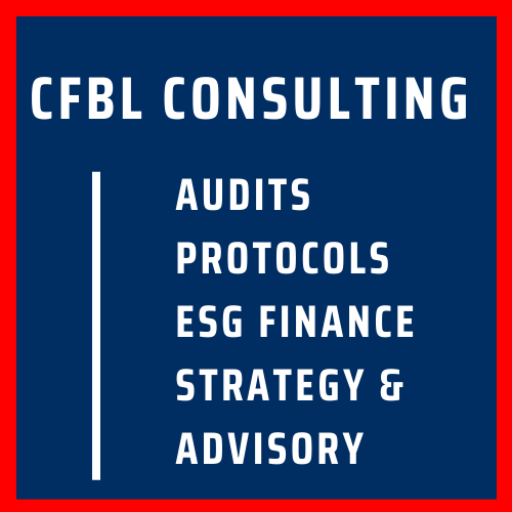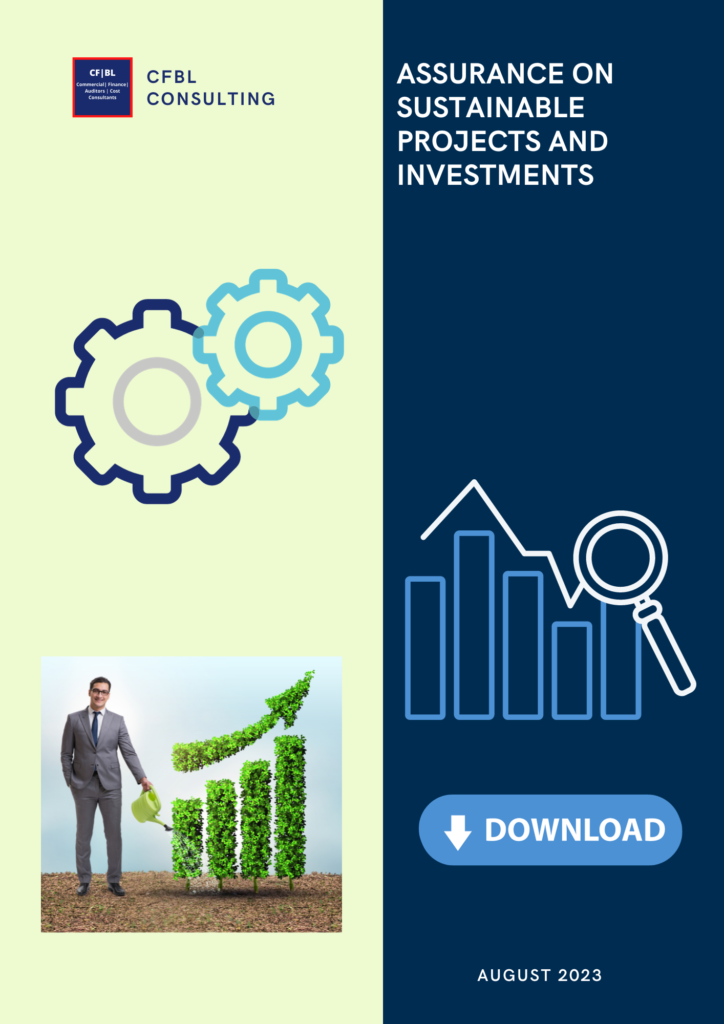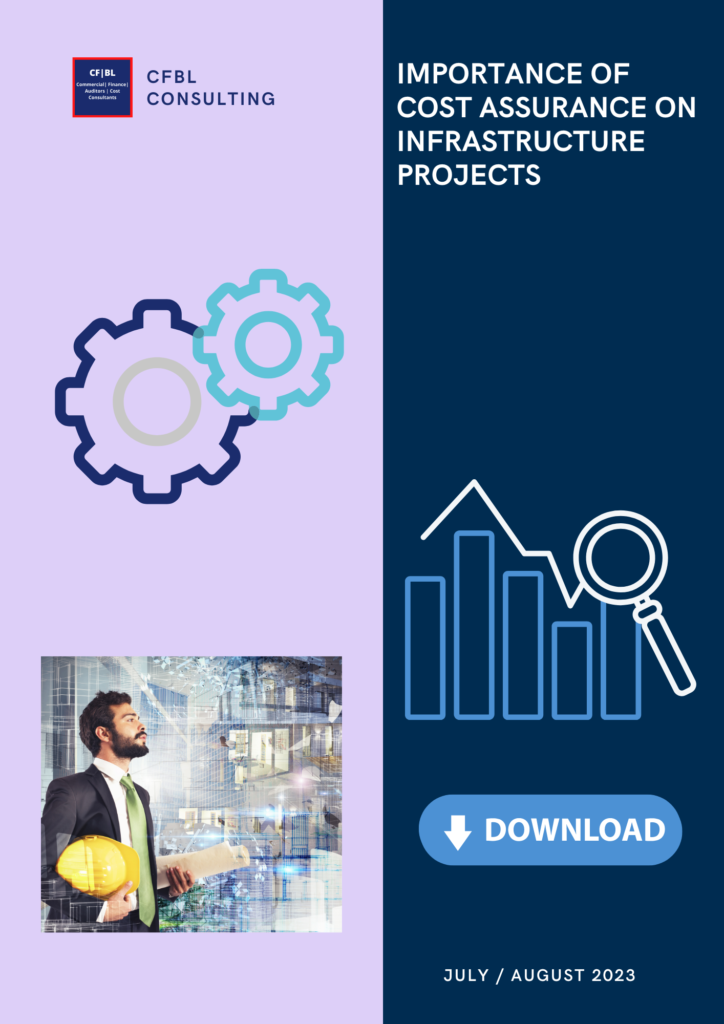Cecelia Fadipe – CFBL
Why is cost assurance important?
in today’s dynamic and competitive world, ensuring cost control in major projects is vital. It safeguards financial stability, commercial integrity, and project success.
Overview
In this paper, CFBL consulting delves into the world of cost assurance on infrastructure projects, emphasising its significance, techniques, and potential advantages. This paper seeks to provide stakeholders in the construction and development sectors with significant insights for navigating the intricacies of infrastructure projects while preserving fiscal discipline by examining real-world case studies, best practises, and innovative strategies.
Introduction
Infrastructure projects play a crucial role in the development and growth of the society. From building roads and bridges to constructing power plants and airports, these projects significantly impact economic progress and quality of life. However, managing infrastructure projects is a complex task that involves numerous challenges, one of the most critical being cost control and assurance. In this article, we will explore the importance of cost assurance on infrastructure projects and how it contributes to their successful delivery.
Cost assurance involves the analysis of current expenditure and potential risks factors that will or could impact the overall project cost in view of minimisng disruptions to revenue-generating activities and maintaining tight control on project costs. It is a systematic process of reviewing and validating expenditure that has been validated and approved, prior to final account payment and discussing costs withheld, responding to queries and tracking issues until mutual resolution is archived.
This is especially crucial in the current economy as businesses with real estate assets must be two steps ahead and prepared for what adverse changes might be evident that could affect them. Along with these factors improvements recommended for implementation that result in success can be monitored, adhered to and strategised further.

Cost Assurance on infrastructure projects
Cost assurance is a key strategic component of long-term sustainability in the infrastructure sector, small cost variations can have significant effects.
Understanding cost assurance
To fully understand cost assurance, one must delve into its essential relevance as a safeguard for financial accuracy and stability. Cost assurance is a crucial element that has a significant impact on the entire project lifecycle when it comes to complex projects, particularly in sectors like infrastructure. It performs a strategic enabling function for long-term sustainability and performance, going beyond simple financial control.
Cost assurance is a systematic and thorough procedure that focuses on monitoring and controlling project costs in order to avoid cost overruns and budget deviations. It entails assessing project expenses at various stages, from planning through execution and delivery. The fundamental purpose of cost assurance is to give stakeholders, such as investors, governments, and the general public, confidence that the infrastructure project will be finished within the assigned budget.
Cost assurance, in essence, goes beyond its function as a typical financial management method. It develops into a proactive strategy that encourages transparency, accountability, and trust among project stakeholders. A solid foundation in cost assurance becomes essential as organisations navigate the changing business landscape, where resource optimisation and project quality are crucial.
Importance of cost assurance on infrastructure projects
- To ensure that the costs of the project are in alignment with the planned budget and are managed effectively and efficiently.
- Cost assurance is a key component of financial management and project governance, helping to alleviate financial risk and strengthen cost control.
- Cost assurance can assist in minimising uncertainty about project costs, which can raise the project’s probability of success.
- Cost assurance can inform decision makers to take better decisions about the project, for instance about whether to proceed with the project, the order in which the work should be done and the allocation of resources.
- Cost assurance can contribute to identifying and reducing risks that may affect the cost of the project. This can help reduce the possibility of cost overruns and other issues.

Understanding cost overruns & Budget adherence
Budget adherence and cost assurance work together to create a potent force that ensures fiscal responsibility and transparency. They assist organisations in making better financial decisions, improve financial prudence, and promote accountability.
Budget adherence
- In infrastructure projects, budget adherence is the degree to which actual costs and expenses are in line with the initial anticipated or budgeted amounts. It evaluates how well the project team and other stakeholders can control and manage financial resources throughout the project’s lifecycle, making sure that expenses stay within the authorised budget.
- Additionally, as the pandemic spreads around the world, dangers to financial stability have so far been kept in check thanks to continuing policy support. But in several industries, financial vulnerabilities are still high. Asset valuations are inflated in several market groups, and concerns about upside risks to the inflation forecast continue. Although funding costs have increased, emerging and frontier markets still have significant financing needs.
- Low budget adherence, on the other hand, is a sign that the project is experiencing cost overruns—where the actual costs exceed the budgeted amount. Cost overruns can cause financial hardship, delays, and even project failure in some cases.
Cost overruns
- Infrastructure projects that experience cost overruns do so when their real costs end up being more than originally anticipated or budgeted. Large-scale infrastructure projects frequently encounter this problem, which can have serious financial and practical repercussions.
- The size of cost overruns might vary. According to some research, the typical cost overrun for infrastructure projects might be anywhere between 10% and 30%. In extremely rare circumstances, overruns might even be greater than the full amount of the initial budget.
- Project planning is all about accuracy. With about 28% of projects failing due to imprecise cost estimates, it’s clear that your project plan deserves time and attention.
- Inaccurate forecasts about costs, resources, benefits, and estimated durations can bring project risks that could impact your organization’s profitability and growth opportunities.
- Lack of proper cost management, inefficient project design, and underutilization of resources can lead to projects going over budget or even being canceled.

Adapting improved project planning & Risk management
Improved project planning and risk management together form a solid foundation for success. By addressing probable hurdles and implementing contingencies, organisations can foster an innovative and adaptable culture.
Improved project planning
- Current risk identification processes involve examining the major areas of a project, collecting input from personnel, learning from past experience, and applying analytical tools and techniques.
- Most of these approaches identify and manage events independently and tend to identify risks rather than opportunities; these approaches are often complemented with techniques such has SWOT analysis, constraints and Assumption analysis, and Force Field Analysis.
- Large government investment projects are subjected to thorough planning and evaluation regimes, with the goal of documenting the grounds for carrying out a planned project based on expected costs, benefits, and other forecasted outcomes.
- The investment cost is usually of special importance because it is quantifiable and has a direct impact on government budgets.
- Large cost overruns might also jeopardise society’s ability to operate and maintain infrastructure in the long run. As a result, precise cost predictions and efficient project delivery are critical for project success.
Risk management
- An often-overlooked issue is estimating methodology and data access. Large and complex enterprises are fraught with risk.
- Cost estimates should account for uncertainty through risk analysis and the addition of necessary contingencies. The probability of various cost consequences varies.
- Even if we choose the most likely cost of all elements in an estimate, the probability of that amount occurring is less than 30%.
- The need for accurate and up-to-date data is critical in order to assess the project’s costs, performance, and budgeting requirements realistically.
- However, data are not the only requirement for reliable cost estimations; appropriate data processing and a systematic consideration of several implications are also required.

Assessing of risk factors
For sound decision-making and strategic planning, evaluating risk factors is a critical step. It provides foresight and agility necessary to successfully navigate challenging terrain.
Risk assessment
- The success of construction enterprises undertaking projects in international markets is heavily dependent on how risks arising from host country conditions, as well as project-specific risk factors, are managed.
- Although certain individual risk factors may be more significant than others, project success is usually determined by the sum of all risks, risk response techniques, and a company’s capacity to manage them.
- As a result, there is a need to construct a risk model that includes the hazards of conducting business in international markets as well as the factors that affect the manageability of these risks.
- Throughout the whole lifespan of the project, risk assessment is a continuous process. The project team keeps an eye on the effectiveness of reaction plans as well as the risks that have been identified.
- Risk management entails the identification of hazards, the development of a risk model that can be used to quantify the scale of risks, and the implementation of response strategies in order to reach an acceptable risk-return balance.
- According to the survey, 41% of organisations faced cost overruns for worldwide enterprise resource planning (ERP) installation projects as of 2022. Organisations had much fewer overruns last year than this year.

Importance of cost prediction & Risk mitigation
Effective risk mitigation strategies are based on accurate cost projections, which enable firms to allocate resources wisely to deal with impending challenges.
Cost prediction
Cost prediction is an important activity for every corporation since it serves as a precursor for budget prices and resource allocation during the project life cycle. It is difficult to collect input data for the cost estimation process when the scope of work is unknown, which may result in inadequate and approximate estimations.
Here are some key steps:
- The project’s scope should be precisely defined, together with its deliverables, goals, and specifications. A solid scope serves as a foundation for assessing the project’s resource requirements.
- By including contingency amounts in the cost estimation process, account for uncertainties and hazards. Their experience and understanding can provide precise and reasonable cost estimates.
- Cost estimates should be based on historical data from comparable previous projects or industry benchmarks. Historical data offers useful information about usual costs and prospective cost factors for projects of a similar nature.
Risk and mitigation
- The success of construction enterprises undertaking projects in international markets is heavily dependent on how risks arising from host country conditions, as well as project-specific risk factors, are managed.
- Risk management entails the identification of hazards, the development of a risk model that can be used to quantify the scale of risks, and the implementation of response strategies to reach an acceptable risk-return balance.
- Although certain individual risk factors may be more significant than others, project success is usually determined by the sum of all risks, risk response techniques, and a company’s capacity to manage them.
- As a result, there is a need to construct a risk model that includes the hazards of conducting business in international markets as well as the factors that affect the manageability of these risks.

Understanding budgeting methods
Budgeting methods serve as strategic tools that organizations utilize to plan, allocate, and control their financial resources.
Overview on budgeting methods
A thorough examination of different budgeting techniques reveals a wide range of financial management strategies. Organisations use budgeting techniques as crucial frameworks for planning, allocating, and controlling their financial resources. Optimising resource use, coordinating financial planning with organisational goals, and effectively responding to dynamic business environments all depend on an understanding of the subtleties of these approaches.
There are various budgeting systems used in the construction business, each with its own philosophy and approach to the challenge of estimating the budget for a project. Deterministic approaches are the most commonly used, however more complex methods such as Case-Based Reasoning, Regression analysis, and Monte Carlo simulation are frequently used in practise.
This section provides a quick review of various methods in terms of theoretical approach, requirements, accuracy, and risk integration. To create cost estimates, parametric estimating employs historical data and statistical connections. In order to predict costs based on previous projects with similar features, it relies on important project elements and indicators.
Budget methods
- The activity-based budgeting: In this method of budgeting, the project is divided into discrete activities or tasks, and the expenses related to each activity are estimated. This approach offers a thorough picture of project costs and aids in more efficient resource allocation.
- The traditional approach to budgeting: This starts with historical data or past budgets and then makes small adjustments depending on anticipated changes in expenses, inflation, and other factors. While simple, it might not fully take into account alterations in conditions or new project requirements.
- The Benchmarking approach: This entails contrasting the estimated costs of the infrastructure project with those of like endeavours that have already been finished. This technique offers insights into potential changes that may be required for more precise budgeting and aids in the identification of potential expense outliers.
it is essential to include a contingency budget when handling unexpected risks and uncertainties. This additional funding aids in covering potential cost increases or adjustments to the project’s scope.

Evaluating project‘s overall efficiency
Evaluating a project’s overall effectiveness empowers organisation to enhance outcomes, elevate efficiency, and maintain a competitive advantage.
Auditing & Validation
In order to guarantee the correctness, dependability, and compliance of financial information and project performance in infrastructure projects, auditing and validation play key roles. To evaluate the project’s overall efficacy, conformance to standards and rules, and financial health, these tasks entail an impartial and methodical study of numerous project components.
- The main goals of risk-based auditing are to evaluate the project’s risk exposure and the efficiency of its risk management plans. It provides proactive risk minimization and aids in the identification of possible problem areas.
- An independent team within the project-management organisation performs internal audits. In order to provide adequate governance and risk management, it evaluates internal controls, financial reporting, and compliance within the project.
- Examining financial records, transactions, and financial statements to ensure their accuracy and adherence to accounting principles and standards is a component of financial auditing. Financial auditing makes sure that financial information for infrastructure projects, such as cost estimates, budget allocations, and expenditure records, is correct and open.
- Project management efficiency and effectiveness, resource allocation, and project results are evaluated through performance auditing. It assesses whether the project is accomplishing the goals it was designed to, as well as whether resources are being spent effectively.
- A compliance audit makes sure that the project complies with all applicable laws, rules, and contractual requirements. This entails confirming that the project conforms with all applicable laws, including those pertaining to labour, the environment, and safety.

Understanding Challenges and Solutions
Cost overruns can cause financial hardship, project delays, and a negative influence on public opinion and confidence.
Cost overruns
The most common reason for infrastructure project failure is cost overruns, which accounted for 61% of all failures. This is followed by public opposition (25%) and political interference (24%). Other reasons for failure include land issues, unrealistic expectations, and poor communication.
This bar chart illustrates as well that the failure rate of infrastructure projects has increased in recent years.

Factors that lead to infrastructure project failure
There are a range of factors that can lead to the failure of infrastructure projects. These include:
- Unrealistic expectations: Project stakeholders often have unrealistic expectations regarding the cost, schedule and scope of infrastructure projects. This can cause issues to arise further down the line in the project.
- Poor planning and execution: poor planning and execution can also result in infrastructure project failure. These include problems such as underestimating project costs, lack of a clear scope of work, and inadequate project management.
Solutions
- Effective risk assessment, detailed planning, open communication, and adaptive management practises are critical to reducing the risk of cost overruns and ensuring the successful and timely completion of infrastructure projects.
- Ensure realistic budgeting and financial management to secure sufficient funding throughout the project’s lifecycle. Maintain open and consistent communication with stakeholders, fostering collaboration and managing expectations.
- Regularly monitor progress, identify bottlenecks, and adjust strategies accordingly. Develop contingency plans to navigate unforeseen technical, regulatory, or economic issues.
FAQs
Cost assurance is a team activity that includes project managers, financial analysts, risk managers, and other stakeholders. The job may be assigned to a separate cost assurance team or integrated into the project management process.
Why is cost assurance important for a business?
Cost assurance is essential to companies working with infrastructure projects as there are many risks that could have a major impact on the progression of the project.
1. It assists in preventing financial crises and cost overruns during project implementation.
2. It guarantees adherence to financial rules and budgetary restrictions.
3. It increases stakeholders’ trust in the project’s leadership and financial stability.
4. It facilitates informed decision-making by supplying precise and current cost information.
5. It helps prioritise project tasks and allocate resources effectively.
What essential elements of cost assurance are present in infrastructure projects?
- Budget Development: Based on the project’s requirements and scope, develop a comprehensive and reasonable budget.
- Cost estimation: Providing precise estimates of the costs of different project activities, materials, labour, and other resources.
- Cost monitoring: Continually monitoring and examining project costs to find any out-of-budget expenses.
- Cost Control: Putting strategies into place to keep costs under control, avoid overruns, and deal with cost discrepancies.
- Risk management: Recognising potential financial hazards and creating backup measures to reduce them.
- Reporting and Documentation: Regularly updating stakeholders on the status of costs and keeping records of costs.
These are some of the benefits of cost assurance in infrastructure projects:
- Increased project certainty: Cost assurance can assist in minimising uncertainty about project costs, which can raise the project’s probability of success
- Better decision making: Cost assurance can inform decision makers to take better decisions about the project, for instance about whether to proceed with the project, the order in which the work should be done and the allocation of resources.
- Reduced risk: Cost assurance can contribute to identifying and reducing risks that may affect the cost of the project. This can help reduce the possibility of cost overruns and other issues.
- Increased value: Cost assurance can help ensure that the project will be delivered on time, within budget and to the required quality standards. This can help maximise the value of the project.
How does long-term cost assurance assist a project?
An infrastructure project might gain from cost assurance in the long run in a number of ways, including:
- Increased project success by adhering to spending restrictions and achieving financial objectives.
- Enhanced organisational ability in cost management and project management.
- Lessons that can be transferred to upcoming projects from cost assurance activities.
- Enhanced stakeholder confidence in the organization’s ability to efficiently handle funds.
- Avoiding monetary conflicts and legal troubles by making sure that duties connected to costs are met.
Reference
- CFI team (2022) Financial Risk Management Strategies, Corporate Finance Institute. Available at: https://corporatefinanceinstitute.com/resources/risk-management/financial-risk-management-strategies/.
- International Monetary Fund (2021) Global Financial Stability Report, October 2021, IMF. Available at: https://www.imf.org/en/Publications/GFSR/Issues/2021/10/12/global-financial-stability-report-october-2021.
- Mateusz Tomasz Tomanek, Cieslinski, W. and Polasik, M. (2022) Digital Business Models in Sport, Routledge eBooks. Informa. Available at: https://doi.org/10.4324/9781003270126.
- Sonmez Cakir, F. and Adiguzel, Z. (2022) ‘Effects of Innovative finance, strategy, Organization and performance: a Case Study of Company’, International Journal of Innovation Science, ahead-of-print(ahead-of-print). Available at: https://doi.org/10.1108/ijis-08-2021-0146.
- International Monetary Fund (2021) Global Financial Stability Report, October 2021, IMF. Available at: https://www.imf.org/en/Publications/GFSR/Issues/2021/10/12/global-financial-stability-report-october-2021.
- Mateusz Tomasz Tomanek, Cieslinski, W. and Polasik, M. (2022) Digital Business Models in Sport, Routledge eBooks. Informa. Available at: https://doi.org/10.4324/9781003270126.
- Sonmez Cakir, F. and Adiguzel, Z. (2022) ‘Effects of Innovative finance, strategy, Organization and performance: a Case Study of Company’, International Journal of Innovation Science, ahead-of-print(ahead-of-print). Available at: https://doi.org/10.1108/ijis-08-2021-0146.
- Xiuzhen, X., Zheng, W. and Umair, M. (2022) ‘Testing the Fluctuations of Oil Resource Price volatility: a Hurdle for Economic Recovery’, Resources Policy, 79, p. 102982.




